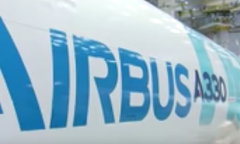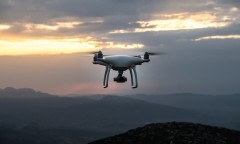By Vishal Goel, | February 04, 2017

Technology giant Google has filed a patent for a drone that would allow users to attend meetings from a remote location without being physically present. The drone, equipped with a screen and a projector for video conferencing, is designed to fly indoors and move from one room to another.
According to an application that was recently updated, the company had patented the small "telepresence" drone for collaborating with colleagues from remote locations, last year.
Like Us on Facebook
According to the application, the drone is an improved alternative to a typical telepresence robot that cannot go upstairs and is difficult to navigate in the unpredictable floor plans that are typical of large tech companies.
The Google patent application suggests a telepresence system on a quadcopter drone that could be much more agile for movement around the room and also in terms of taking up less space, consuming less energy and providing an experience that is more engaging overall than a ground-based robot, reports Recode.
The drone is basically an aircraft that has an H-shaped frame, a structure which Google thinks might prove more capable of carrying a rotating screen and still be constructed from lightweight material. The drone would also carry a projector for beaming images from the remote pilot onto surfaces like walls in the room, as well as an audio system for voice communication between participants.
In the updated patent, the screen system of the aircraft would adjust itself to maintain an aerodynamic position as it flies, as well as the projection system that can sense image distortion to self-correct accordingly.
Although Google is primarily describing the drone as a way for colleagues to collaborate with each other from different remote locations, the company has also mentioned about how it could be used by "a medical professional consulting with a patient and/or another medical professional at a different location" or "an instructor providing instruction to students at remote locations."
The application also shows how a smartphone could be docked to the drone and used for the onboard processing and control of the aircraft, as well as the drone's audio and video functions.
-
Use of Coronavirus Pandemic Drones Raises Privacy Concerns: Drones Spread Fear, Local Officials Say

-
Coronavirus Hampers The Delivery Of Lockheed Martin F-35 Stealth Fighters For 2020

-
Instagram Speeds Up Plans to Add Account Memorialization Feature Due to COVID-19 Deaths

-
NASA: Perseverance Plans to Bring 'Mars Rock' to Earth in 2031

-
600 Dead And 3,000 In The Hospital as Iranians Believed Drinking High-Concentrations of Alcohol Can Cure The Coronavirus

-
600 Dead And 3,000 In The Hospital as Iranians Believed Drinking High-Concentrations of Alcohol Can Cure The Coronavirus

-
COVID-19: Doctors, Nurses Use Virtual Reality to Learn New Skills in Treating Coronavirus Patients











